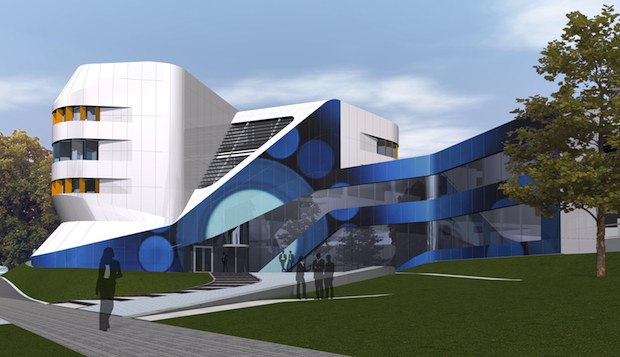
Artist’s rendering shows how the Fraunhofer IAO building in Stuttgart, Germany could be fitted with a colorful solar façade. Credit: Fraunhofer IOF.
Until now, covering a building’s roof or façade with standard solar photovoltaic cells would change the structure’s appearance—and not always for the better. Current cell arrays are black or gray, colors governed simply by the need to maximize solar collection efficiency.
Researchers at Fraunhofer Institute for Applied Optics and Precision Engineering (IOF; Jena, Germany) are working to change that, according to this news release. “Not enough work has been done so far on combining photovoltaics and design elements to really do the term ‘customized photovoltaics’ justice,” says project manager Kevin Füchsel in the release.
Füchsel and his team have been working for four years to develop cost-effective manufacturing processes to increase solar panel efficiency design flexibility for architects and designers. The work includes developing production processes for colored solar cells from thin-film silicon wafers. “To enable lots of light to reach the silicon substrate, the semiconductor layer is given an optically neutral protective barrier (insulator), onto which a 100-nm thick conductive oxide layer is applied,” the release explains. The TCO acts as a waveguide to transmit light to the semiconductor layer and also serves as an antireflective coating.
The researchers are now working on how to use aluminum-doped zinc oxide for the oxide layer. The zinc oxide-based material would be much cheaper than current indium-tin oxide materials, the release says.
The manufacturing processes developed at IOF result in PV cells that capture more light and can be made in different colors and shapes, according to Füchsel. “The color comes from changing the physical thickness of the transparent conductive oxide layer, or modifying its refractive index,” he says. “Giving solar cells color doesn’t really affect their efficiency. The additional transparent TCO layer has barely any impact on the current yield.” However, there are differences in the amounts of electricity that can be generated by different color panels—according the news release, red, blue, and green panels may suffer a slight decrease in efficiency compared with other colors.
IOF researchers are also developing an inkjet printing process to deposit the conductive TCO layer to further speed manufacturing and increase design flexibility, the release says. Patents already cover the production of colored cells and the ability to integrate design elements into solar panels and whole modules. “This opens up numerous possibilities to use a building to communicate information, displaying the name of a company or even artistic pictures,” Füchsel says.

